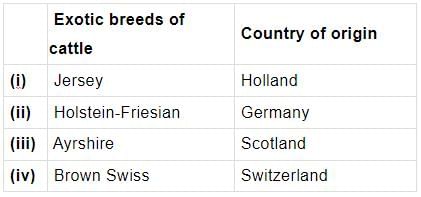Test: Animal Husbandry (Old NCERT) - NEET MCQ
15 Questions MCQ Test Biology Practice Tests: CUET Preparation - Test: Animal Husbandry (Old NCERT)
Which of the following is the "bird flu virus"?
| 1 Crore+ students have signed up on EduRev. Have you? Download the App |
Given below are four statements (A - D) each with one or two blanks. Select the option which correctly fills up the blanks in any two statements.
(A) Multiple ovulation (i) transfer technology is for (ii) improvement.
(B) In it a cow is administered (i) to induce follicular maturation and (ii) ovulation.
(C) Instead of one egg per cycle, (i) eggs are produced through it.
(D) The fertilised (i) at (ii) celled stages are recovered non-surgically and transferred to surrogate mothers.
(A) Multiple ovulation (i) transfer technology is for (ii) improvement.
(B) In it a cow is administered (i) to induce follicular maturation and (ii) ovulation.
(C) Instead of one egg per cycle, (i) eggs are produced through it.
(D) The fertilised (i) at (ii) celled stages are recovered non-surgically and transferred to surrogate mothers.
Study the following statements regarding inbreeding and select the incorrect ones.
(i) The inbreeding strategies allow the desirable ualities of two different breeds to be combined.
(ii) It increases homozygosity.
(iii) It also helps in elimination of less desirable genes.
(iv) Continued inbreeding increases fertility and productivity.
Artificial breeding of cattle is brought about by
Crossing of individuals of two different species to produce a hybrid is called
A is an improved breed of cattle and B is an improved breed of chicken, Which of the following options correctly identifies A and B?
Given below are four statements (i)-(iv). Which two of the following statements are correct?
(i) It is estimated that more than 70 percent of the world livestock population is in India and China.
(ii) Stringent cleanliness and hygiene (both of the cattle and the handlers) are paramount importance while milking, storage and transport of the milk and its products.
(iii) Out-breeding is the breeding between animals of the same breed only.
(iv) Crosses between different breeds is called inbreeding.
Which of the following two matches are incorrect?

Which of the following is a drought breed of Indian cattle?
Which of the following procedures are followed in dairy farm management?
(i) Regular inspections and visits by veterinary doctors.
(ii) Usage of manure to increase crop yields.
(iii) Adequate environmental condition is provided.
(iv) Weeding away unproductive and harmful plants from the brood house.
Select the incorrect statement from the following.

















